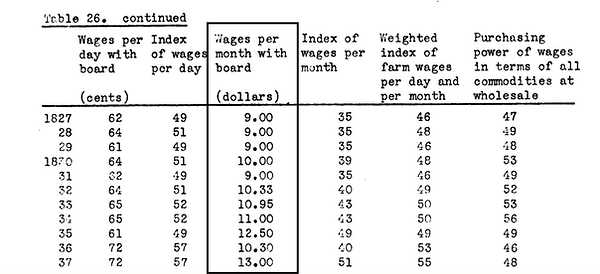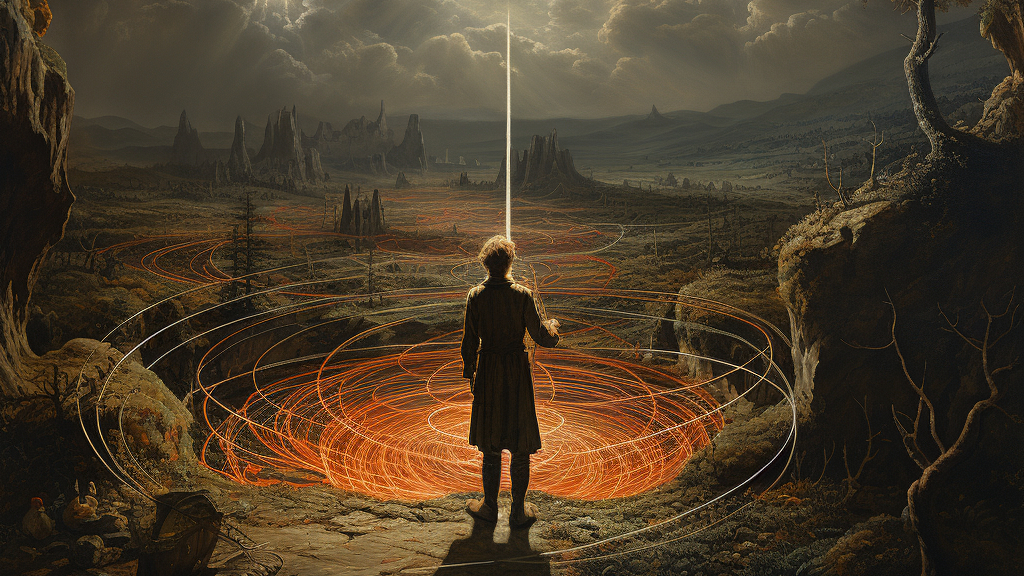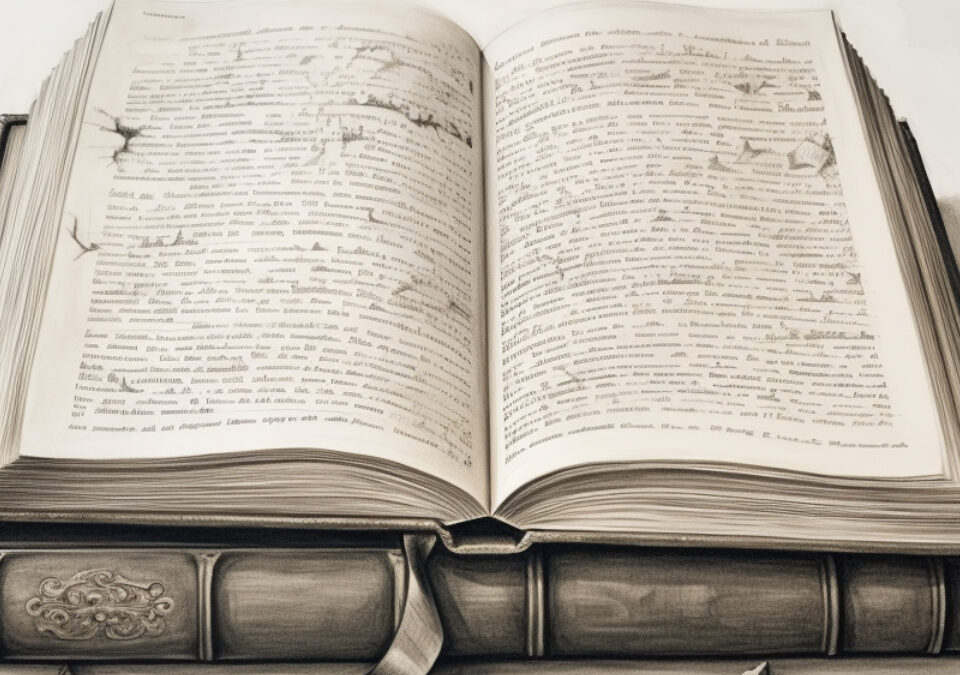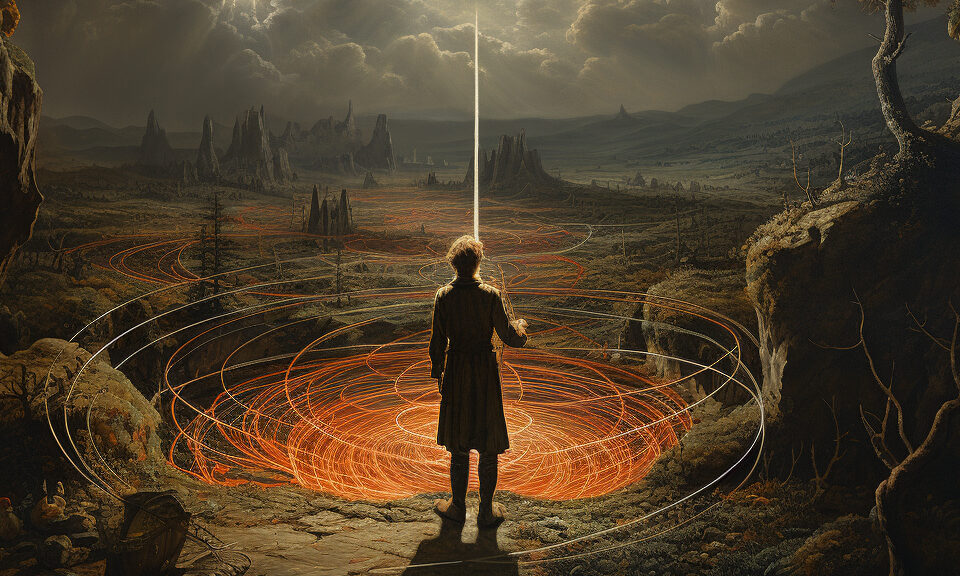
3. Joseph Smith Treasure Digging Flowchart
October 6, 2024
Emotional Appeal: The Core of The Triumph of Hope by Elder Neil L. Andersen
October 8, 2024Joseph Smith practiced treasure digging and was a popular treasure seeking seer. The magical device he used for treasure seeking was a seer stone.
Table of contents
- Joseph Smith practiced treasure digging and was a popular treasure seeking seer. The magical device he used for treasure seeking was a seer stone.
- A1) Joseph Smith used peep/seer stones, claiming to find lost buried treasure.
- A2) Joseph would take his peep/seer stone, put it inside of a hat, and put his head in the hat to block out all light and then tell people where to dig.
- A3) Evidence suggests Joseph conducted multiple treasure digs (among other seer stone work) between 1822-1827. In 1826 he was put on trial as a conman for his treasure digs funded by Josiah Stowell.
- A4) For many years church apologist downplayed the credibility of a trial against Joseph Smith as an impostor. Joseph Smith being a treasure digger using a peep/seer stone now is accepted.
- A5) A docket entry in 1826 outlining the case of Joseph Smith on charges of being a “glass looker” (another name for peep/seer stone user) states that Joseph Smith was found guilty of being a “disorderly person and an impostor.”
- A6) As with all treasure diggers, Joseph Smith never found any treasure.
- A7) The church used to deny or downplay that Joseph Smith was an active treasure digger, however have recently published a gospel topics essay admitting he was a treasure digger.
- A8) One year after being on trial, Joseph stopped treasure digging and used the exact same peep/seer stone and method to translate the Book of Mormon.
- A9) Although Joseph never found treasure, evidence suggests the wages for a seer was about 50% more than the diggers and required no physical labor.
- A10) Of note, treasure digging language shows up in aspects of the Book of Mormon.
- A11) The act of looking into seer stones continued to be endorsed through Joseph Smith’s life and further into Brigham Young’s and Heber C. Kimball
- Issues these Facts Raise
- Questions these Facts Raise
A1) Joseph Smith used peep/seer stones, claiming to find lost buried treasure.
Supporting Sources and Quotes
“As a young man during the 1820s, Joseph Smith, like others in his day, used a seer stone to look for lost objects and buried treasure.”
- Book of Mormon Translation gospel topics essay on church’s website. (See also: Bushman, Joseph Smith and the Beginnings of Mormonism, 64–76; and Richard Lloyd Anderson, “The Mature Joseph Smith and Treasure Searching,” BYU Studies 24, no. 4 [Fall 1984]: 489–560.)
Elder Steven E. Snow, LDS Church Historian, noted: “By 1825, young Joseph had a reputation in Manchester and Palmyra for his activities as a treasure seer, or someone who used a seer stone to locate gold or other valuable objects buried in the earth.”
-Ensign, September 2015, “Joseph Smith in Harmony”.
There are multiple accounts of this, but here is one for flavor:
Martin Harris, 1859: “There was a company there in that neighborhood, who were digging for money supposed to have been hidden by the ancients… They dug for money in Palmyra, Manchester, also in Pennsylvania, and other places. When Joseph found this stone, there was a company digging in Harmony, PA., and they took Joseph to look in the stone for them, and he did so for a while, and then he told them the enchantment was so strong that he could not see, and they gave it up.”
- Joel Tiffany, “Interview with Martin Harris,” Tiffany’s Monthly, August 1859; Transcript available here.
“Now, most historians, Mormon or not, who work with the sources, accept as fact Joseph Smith’s career as village magician. Too many of his closest friends and family admitted as much, and some of Joseph’s own revelations support the contention.”
- BYU Historian Marvin S. Hill, from a review by Marvin S. Hill of Rodger I. Anderson's book Joseph Smith's New York Reputation Reexamined, found in BYU Studies, Volume 30:4 (Fall 1990). Review found on BYU website here.
“Church scholars now acknowledge that he had a seer stone and did look for lost objects as a young man.”
- Richard L. Bushman, “Joseph Smith and Money Digging”, Available on BYU website here.
“The young Joseph Smith accepted such familiar folk ways of his day, including the idea of using seer stones to view lost or hidden objects. Since the biblical narrative showed God using physical objects to focus people’s faith or communicate spiritually in ancient times, Joseph and others assumed the same for their day. Joseph’s parents, Joseph Smith Sr. and Lucy Mack Smith, affirmed the family’s immersion in this culture and their use of physical objects in this way, and the villagers of Palmyra and Manchester, New York, where the Smiths lived, sought out Joseph to find lost objects before he moved to Pennsylvania in late 1827.”
⁃Ensign, “Joseph the Seer”, October 2015 by Richard E. Turley Jr., Assistant Church Historian and Recorder, Robin S. Jensen and Mark Ashurst-McGee, Church History Department
“In frontier America, seer stones or “peep stones” were commonly used by lost object finders, people engaged in the widespread practice of lost treasure digging, and sometimes by people seeking to uncover the kind of truths we might call a private or police detective for today. It is unclear how much of this kind of activity Joseph Smith was involved in, except for water divining and treasure digging, which are widely attested.”
- Eric A. Eliason, “Seer Stones, Salamanders, and Early Mormon “Folk Magic” in the Light of Folklore Studies and Bible Scholarship”, BYU Studies Quarterly, Vol.55, No.1, 2016
A2) Joseph would take his peep/seer stone, put it inside of a hat, and put his head in the hat to block out all light and then tell people where to dig.
Supporting Sources and Quotes
“Joseph Smith and his associates’ involvement in practices such as dowsing for water with divining rods and searching for buried treasure with seer stones had long been known to historians, as was the common, but not uncontroversial, nature of such practices in Joseph Smith’s time. In the 1980s, new research suggested a more in-depth and ongoing involvement with “magical” practices than was previously understood—as evidenced perhaps by occult volumes in the Palmyra library and by the Smith family’s possession of a Jupiter talisman, an astrological dagger, and magical parchments.”
- Eric A. Eliason, “Seer Stones, Salamanders, and Early Mormon “Folk Magic” in the Light of Folklore Studies and Bible Scholarship”, BYU Studies Quarterly, Vol.55, No.1, 2016
"Joseph Smith would put the seer stone into a hat, and put his face in the hat, drawing it closely around his face to exclude the light; and in the darkness the spiritual light would shine. A piece of something resembling parchment would appear, and on that appeared the writing. One character at a time would appear, and under it was the interpretation in English. Brother Joseph would read off the English to Oliver Cowdery, who was his principal scribe, and when it was written down and repeated to Brother Joseph to see if it was correct, then it would disappear, and another character with the interpretation would appear. Thus the Book of Mormon was translated by the gift and power of God, and not by any power of man." David Whitmer, Address to All Believers in Christ Part 1 (1886)
- “Firsthand Witness Accounts of the Translation Process” by Gerrit J. Dirkmaat and Michael Hubbard MacKay at BYU Religious Studies Center
“Joseph Smith’s critics often tried to disparage him by calling him a money digger or a treasure seeker. Rather than deny the charge, Joseph acknowledged in his official history that Josiah Stowell had hired him in 1825 to assist in a treasure-seeking venture in northern Pennsylvania. Stowell wanted his help because Joseph was reputed by some of his neighbors to be a “seer”—someone who could look into a special stone and find lost or hidden objects.
“Seeing” and “seers” were part of the culture in which Joseph Smith grew up. Some people in the early 19th century believed it was possible for gifted individuals to see lost objects by means of material objects such as stones. Joseph Smith and his family, like many around them, accepted these familiar folk practices.”
- LDS Website, “Treasure Seeking”
This is referenced merely because of the succinct overview of the topic. The Wikipedia article also holds several relevant references for those looking to go deeper on this sub-topic.From Wikipedia: Smith's usual procedure was to place the stone in a white stovepipe hat, put his face over the hat to block the light, and "see" the necessary information in the stone's reflections.Smith and his father achieved "something of a mysterious local reputation in the profession—mysterious because there is no record that they ever found anything despite the readiness of some local residents to pay for their efforts."
A3) Evidence suggests Joseph conducted multiple treasure digs (among other seer stone work) between 1822-1827. In 1826 he was put on trial as a conman for his treasure digs funded by Josiah Stowell.
Supporting Sources and Quotes
One witness at the trial, Jonathan Thompson, testified on Joseph Smith’s behalf. “He reported digging with the seer (Joseph Smith) in pursuit of a “chest of money.” Thompson “struck his spade upon . . . probably the chest, but on account of an enchantment, the trunk kept settling away from under them while digging.”” (Docket Entry, 1826) In other words, Thompson believed that Joseph Smith not only could see the treasure chest of money, but that they had struck it during the dig before it slipped out of their reach.
Josiah Stowell, who was paying for the dig, “similarly described a dig in which the “money moved down” beyond their reach. Joseph testified on his own behalf, insisting in his defense that he used a seer stone to help others look for “hidden treasures in the bowels of the earth,” despite never once having found any.”” (see other Docket entry)
“The clergy had done their best to purge magic from the lives of the European populace, but with limited success. Not just the poor and ignorant but people at all levels had believed in magic and practiced its rituals, without sensing any contradiction with their Christian belief. Christianity and magic were blended into a kind of general faith in super-natural powers. That scholarship helped me understand Joseph Smith, because the sources made it clear that not just the Smith family but many people in the neighborhood were invoking spells and rituals to find buried treasure while still claiming to be believing Christians.”
- Richard L. Bushman, “Treasure-seeking Then and Now,” Sunstone, v. 11, September 1987, p. 5
“Some of Joseph’s New York neighbors remembered him dowsing in his youth. He may have taken up the rod for a number of reasons. While Joseph’s mother practiced wisdom divination, his father dowsed with a rod.”
Later in the same article, “Whereas the Smiths used forked hazel rods to find water in their early New York years, they may have used mineral rods when they began treasure divining.”
⁃See 2000 Thesis, “A Pathway to Prophethood: Joseph Smith Junior as Rodsman, Village Seer, and Judeo-Christian Prophet” by Mark Ashurst-McGee.
Evidence suggests Joseph grew up with his father Joseph Smith Sr being a treasure digger., “When did father Smith begin using a divining rod? In 1843, Mormon schismatic James C. Brewster-who had searched for treasure with Joseph Smith, Senior, in the Kirtland, Ohio, area-recounted that in the summer of 1837 the elder Smith claimed, ‘I know more about money digging, than any man in this generation, for I have been in the business more than thirty years.’ If Brewster can be trusted, Joseph had been hunting treasure as far back as 1807. One might hazard the guess that he began treasure hunting sometime between 1797 and 1807. If he hunted before this time, he would have claimed to have been in the business more than forty years. Brewster's reminiscence dates Joseph Smith Senior's treasure hunting back to his Vermont years. He moved New York in 1816. Vermont sources affirm that Joseph did dig for treasure there.”
⁃2000 Thesis, “A Pathway to Prophethood: Joseph Smith Junior as Rodsman, Village Seer, and Judeo-Christian Prophet” by Mark Ashurst-McGee
Joseph Smith, founding prophet of the Mormon religion, had participated in several treasure-hunting expeditions in his youth.
- Mark Ashurst-McGee, Moroni as Angel and as Treasure Guardian, BYU
Further Resource and analysis of 18 potential major dig sites: Dan Vogel, “The Locations of Smith’s Early Treasure Quests,” Dialogue: A Journal of Mormon Thought 27, No. 3
A4) For many years church apologist downplayed the credibility of a trial against Joseph Smith as an impostor. Joseph Smith being a treasure digger using a peep/seer stone now is accepted.
Supporting Sources and Quotes
- Richard L. Bushman, “Joseph Smith and Money Digging”, Available on BYU website here.
For many years church apologists downplayed the credibility of this trial, with noted LDS scholar and apologist Hugh Nibley declaring in his book The Myth Makers that "Now, Bishop Tuttle, if this court record is authentic it is the most damning evidence in existence against Joseph Smith.” and that it would be “the most devastating blow to Smith ever delivered.”
This was written before the court records were unearthed, which showed that Joseph Smith was indeed brought to trial in 1826 in a case where Joseph Smith was called “The Glass Looker.” (see below item A5).
“That scholarship helped me understand Joseph Smith, because the sources made it clear that not just the Smith family but many people in the neighborhood were invoking spells and rituals to find buried treasure while still claiming to be believing Christians....But what intrigues me still more is that nowhere, so far as I can see, did the revelations ever repudiate treasure-seeking. Joseph had no reason to believe that it was all superstitious hogwash, as we are inclined to think today.” - Richard L. Bushman, “Treasure-seeking Then and Now,” Sunstone, v. 11, September 1987, p. 5
A5) A docket entry in 1826 outlining the case of Joseph Smith on charges of being a “glass looker” (another name for peep/seer stone user) states that Joseph Smith was found guilty of being a “disorderly person and an impostor.”
Supporting Sources and Quotes
The church provides an overview and commentary essay of the 1826 trial here: https://www.churchofjesuschrist.org/study/history/topics/joseph-smiths-1826-trial?lang=eng
This overview and commentary essay does corroborate:
- Joseph was hired to act as a treasure-seeking seer: “In 1826, Josiah Stowell hired Joseph Smith to help look for lost Spanish silver near the border of New York and Pennsylvania. Someone in the community, possibly a member of Stowell’s extended family, accused Joseph of gazing into a stone to discover lost property. As a result, Joseph was ordered to appear before justice of the peace Albert Neely in Chenango County, likely on charges of disorderly conduct.”
- Gazing into a stone to find lost property was illegal at the time: “As a result, Joseph was ordered to appear before justice of the peace Albert Neely in Chenango County, likely on charges of disorderly conduct. His arrest appears to have been based on a statute in New York state law outlawing “pretending . . . to discover where lost goods may be found.”
- Various accounts of the trial exists with different claims of what happened (either condemned or acquitted): “A purported court record indicates the judge found Joseph guilty. A neighbor of Josiah Stowell claimed the court “condemned” Joseph but allowed him to escape on account of his youth. A friend of the judge who claimed to have taken notes at the hearing wrote that the judge accepted Stowell’s testimony and discharged Joseph.” (See footnote 2 in the church essay for an overview of the four different sources).
A docket entry printed in 1886 outlines the 1826 case against Joseph Smith as a “disorderly person and an impostor” and ends with the following statement: “And therefore the court find the defendant guilty.” You can read this on the Joseph Smith Papers, and can see that this suggest that not only did the trial happen, but that a guilty verdict handed down. Didn’t try to track down the other sources mentioned in church article below. The docket entry itself claims to be the “exact trial and conviction of Joseph Smith” copied from the transcript of Justice of the Peace Pearsall, who was the Judge over the trial.
A6) As with all treasure diggers, Joseph Smith never found any treasure.
Joseph Smith never found any money or treasure that he claimed to see using his seer stone. Logically, the church would advertise the fact or bring this to the forefront if he ever had as it would be evidence of being a successful seer. There is no recorded instance indicating that Joseph could see and locate treasure in the stones.
A7) The church used to deny or downplay that Joseph Smith was an active treasure digger, however have recently published a gospel topics essay admitting he was a treasure digger.
See discussion of trials in future sections.
Supporting Sources and Quotes
The church’s essay is found here: https://www.churchofjesuschrist.org/study/history/topics/treasure-seeking?lang=eng
Joseph Fielding Smith did admit to Joseph Smith being an active treasure digger when he quoted Joseph Smith: Smith later commented on his working as a treasure hunter: "'Was not Joseph Smith a money digger?' Yes, but it was never a very profitable job for him, as he only got fourteen dollars a month for it."
- Smith, Joseph Fielding (1976), Teachings of the Prophet Joseph Smith, Salt Lake City: Deseret Book, ISBN 0-87747-626-8. Also Joseph Smith, Elders' Journal of the Church of Jesus Christ of Latter Day Saints [Kirtland, Ohio] 2 no. 3 (July 1838), 43. Also reproduced in Teachings of the Prophet Joseph Smith, 120; History of the Church 3:29; Discourses of the Prophet Joseph Smith, 271.
Note: See A9 for information related to “only got fourteen dollars a month”.
A 1985 memorandum sent from the headquarters of the LDS Church Educational System to regional and local administrators read, "Even if the [Mark Hofmann] letters were to be unauthentic, such issues as Joseph Smith's involvement in treasure-seeking and folk magic remain. Ample evidence exists for both of these, even without the letters."
- D. Michael Quinn 1998, p. xx–xxi, Early Mormonism and the Magical Worldview
A8) One year after being on trial, Joseph stopped treasure digging and used the exact same peep/seer stone and method to translate the Book of Mormon.
This is further discussed in the Book of Mormon section.
Supporting Sources and Quotes
“According to these accounts, Joseph placed either the interpreters or the seer stone in a hat, pressed his face into the hat to block out extraneous light, and read aloud the English words that appeared on the instrument.”
- Book of Mormon Translation gospel topics essay on church’s website.
David Whitmer, one of the Three Witnesses, described Smith's method of translation: "Joseph Smith would put the seer stone into a hat, and put his face in the hat, drawing it closely around his face to exclude the light; and in the darkness the spiritual light would shine. A piece of something resembling parchment would appear, and on that appeared the writing. One character at a time would appear, and under it was the interpretation in English. Brother Joseph would read off the English to Oliver Cowdery, who was his principal scribe, and when it was written down and repeated to Brother Joseph to see if it was correct, then it would disappear, and another character with the interpretation would appear. Thus the Book of Mormon was translated by the gift and power of God, and not by any power of man."
- David Whitmer, Address to All Believers in Christ Part 1 (1886)
In addition to rod and stone divining, the Smiths probably believed in the rudimentary astrology found in the ubiquitous almanacs. Magical parchments handed down in the Hyrum Smith family may have originally belonged to Joseph Sr. The visit of the angel and the discovery of the gold plates would have confirmed the belief in supernatural powers. For people in a magical frame of mind, Moroni sounded like one of the spirits who stood guard over treasure in the tales of treasure-seeking.
- Richard L. Bushman, Joseph Smith: Rough Stone Rolling. Knopf Books.
A9) Although Joseph never found treasure, evidence suggests the wages for a seer was about 50% more than the diggers and required no physical labor.
Not that this matters to the main point, but to follow up from quote in A7.
Supporting Sources and Quotes
“In 1838 the church’s periodical published an interview with the Mormon prophet: “Question 10. Was not Jo Smith a money digger. Answer. Yes, but it was never a very profitable job to him, as he only got fourteen dollars a month for it.”273 However, his mother said Stowell “offered high wages.”274 In fact, Joseph’s income as Stowell’s treasure-seer was significantly higher than the monthly wage of workers on the nearby Erie Canal.”
- D. Michael Quinn, Early Mormonism and the Magical Worldview.
A9.2 - In 1827, farm laborers were paid just nine dollars a month in Vermont. (University of Vermont and State Agricultural College) This indicates Joseph Smith made over 50% more as a money digger, while also avoiding the hard labor of digging as he was the “seer” who would sit with the rock in a hat while directing the others on where to dig. Table of wages below:

A10) Of note, treasure digging language shows up in aspects of the Book of Mormon.
This is further discussed in the Book of Mormon section.
Supporting Sources and Quotes
"And behold, the time cometh that he curseth your riches, that they become slippery, that ye cannot hold them; and in the days of your poverty ye cannot retain them....Yea, we have hid up our treasures and they have slipped away from us, because of the curse of the land....Yea, in that day ye shall say: O that we had remembered the Lord our God in the day that he gave us our riches, and then they would not have become slippery that we should lose them; for behold, our riches are gone from us." (Helaman 13)
A11) The act of looking into seer stones continued to be endorsed through Joseph Smith’s life and further into Brigham Young’s and Heber C. Kimball
Supporting Sources and Quotes
“In later years, as Joseph told his remarkable story, he emphasized his visions and other spiritual experiences. Some of his former associates focused on his early use of seer stones in an effort to destroy his reputation in a world that increasingly rejected such practices. In their proselyting efforts, Joseph and other early members chose not to focus on the influence of folk culture, as many prospective converts were experiencing a transformation in how they understood religion in the Age of Reason. In what became canonized revelation, however, Joseph continued to teach that seer stones and other seeric devices, as well as the ability to work with them, were important and sacred gifts from God.”
⁃Ensign, “Joseph the Seer”, October 2015 by Richard E. Turley Jr., Assistant Church Historian and Recorder, Robin S. Jensen and Mark Ashurst-McGee, Church History Department
Doctrine and Covenants 130:10-11: 10 Then the white stone mentioned in Revelation 2:17, will become a Urim and Thummim to each individual who receives one, whereby things pertaining to a higher order of kingdoms will be made known;
11 And a white stone is given to each of those who come into the celestial kingdom, whereon is a new name written, which no man knoweth save he that receiveth it. The new name is the key word.
After Smith's death, Brigham Young endorsed their use. In 1855, he reminisced, "Joseph said there is a [seer] Stone for every person on Earth." At the first general conference after Smith's death, Young declared, "The president of the priests has a right to the Urim and Thummim, which gives revelation."
- Quinn, D. Michael (1998), Early Mormonism and the Magic World View (2nd ed.), Reference is History of the Church, 7:285
“On his return, Joseph gave rods to Kimball and to Brigham Young. Kimball held his rod when praying for revelation.” And later in footnote 98: “Kimball recorded rod revelations in his diaries and specified them as such (Stanley B. Kimball, Heber C. Kimball: Mormon Patriarch and Pioneer [Urbana: University of Illinois Press, 1981], 248-49”
⁃2000 Thesis, “A Pathway to Prophethood: Joseph Smith Junior as Rodsman, Village Seer, and Judeo-Christian Prophet” by Mark Ashurst-McGee (who is quoted as a Church Historian in Ensign articles)
“Last nite I clothed my self and offered up the Sines [signs] of the Holy Preasthood and called one [on] the name of the Lord. He hurd me fore my heart was mad[e] comfortable. I inquired by the rod. It was said my family was well, that my wife would come to me in the East, and that Congress would not do anything fore us.”
- Prophet Heber C. Kimball, Heber C. Kimball diary, June 6, 1844, in Kimball, On the Potter's Wheel, p. 65 (Available online here)
Issues these Facts Raise
It feels like Joseph Smith is using the same modus operandi of a well-known con later as the means for translating the Book of Mormon and being a religious seer. Evidence also suggests he was also a convicted as an impostor. The practice was illegal at the time. To me it would seem plausible that after being convicted he needed to move on to other means of finding income. Shortly after Joseph Smith using the exact same treasure digging seer stone method to begin a religion. I don’t like this correlation. It feels like a natural progression.
If I were talking about another religion and stated that it started by a convicted conman who used the exact same instruments and modus operandi to create said religion, to me that would require a lot more evidence of divine inspiration to overcome. Honestly, if it were any other religion or any other “prophet” that would be enough for me to likely reject the later claims of that prophet.
Questions these Facts Raise
If Joseph Smith were God’s prophet beginning at age 14, what would we expect to see? If Joseph Smith were a conman, what would we expect to see? Which does the facts of his treasure digging more likely lend itself to? Treasure digging would be a type of acting as a seer. Is this relevant to later times he acts as seer?
Why is it more plausible that God was preparing Joseph Smith to be his prophet by using a well-known con technique than Joseph Smith was being a fraud, just like every other treasure digger?
Are we to believe that Joseph Smith really did see treasure in his hat and that it was “becoming slippery” whenever the dig got close, and that it was guarded by guardian spirits—all as Joseph believed and taught? If Joseph did not believe this and taught it, wouldn’t he be a knowing fraud and conman? If Joseph did believe it (and it was false) and taught it, wouldn’t this have bearing on his trustworthiness of what he believed? Wouldn’t that mean he was actually seeing false visions in his hat? Or are we to believe that he was seeing true visions in his hat and that there is hidden Spanish gold that inexplicably is buried near where he grew up protected by guardian spirits and that if performing magic spells under the right conditions and looking at a magic stone will indeed produce reliable visions and that cursed gold can become slippery and move on its own deeper into the earth?
Hard for me to see this as anything but a no win situation for truth claims of Joseph, see Joseph Smith Treasure Digging flowchart for analysis.
If Joseph Smith was using these methods, what necessarily needs to change about my belief in prophets or God in order for this to continue to bolster the truth claims of the church?
D. Michael Quinn wrote in Early Mormonism and the Magical Worldview, “Hugh Nibley also wrote that if genuine, the court record “is the most devastating blow to Smith ever delivered.”” Referring to Joseph Smith being on trial (or maybe he was referring to being convicted at the trial?). My understanding is that originally it was believed that he was never on trial or convicted, which is when Hugh Nibley made his statement, but later it was proved he was. Why would Hugh Nibley say this would be the most devastating blow to Smith ever delivered and is that valid? Why or why not?
If treasure digging was supposed to be preparatory to Joseph Smith, why didn't he graduate? Why use the exact same method for translation? Why keep occult items his whole life? Why have evidence he practiced astrology his whole life? Why pass on things like his magic cane (coffin canes or canes of martyrdom) to Brigham Young? (See Wikipedia for examples: https://en.m.wikipedia.org/wiki/Cunning_folk_traditions_and_the_Latter_Day_Saint_movement)
How can we best decide between a true prophet of God and a false prophet? How can we best decide between a true treasure digger and a false treasure digger?
Is it plausible that Joseph Smith’s religious experience is a product of his and his families practice of occult, folk magic, and astrology?
What if what I was taught about Joseph Smith wasn’t true? How would I know? How would I be different from those who Joseph “helped” find lost treasure?
How can we tell the difference between something supernatural and something that doesn't exist? How does that apply to Joseph Smith and his supernatural claims?



